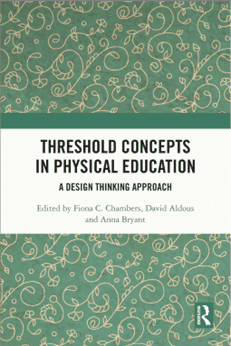
Introduction
This book brings together two fantastic theories; threshold concepts and design thinking both of which have a huge role to play in supporting the future direction of PE. The word ‘concepts’ associated with physical education (PE) has become one of the most talked about areas in the past couple of years. I would advise anyone involved in the teaching or teacher education of PE to engage with this work by Fiona Chambers, Anna Bryant and David Aldous published in 2021. The book considers theory and practice in relation to curriculum, pedagogy and assessment. Importantly, it considers all four domains of learning (cognitive, psychomotor, affective and social) that we know are imperative to high-quality study in, through and about PE.
If you have not yet come across the idea of design thinking, it is a process that really helps deep thinking about and generating solutions for an identified ‘wicked problem’ (p1):
Wicked Problem Statement:
Description: As a profession, we do not appear to have an agreed matrix of threshold concepts for PE.
Learning Need: PE educators need to identify threshold concepts for PE so that they can plan implement and assess learning in and through PE.
Insight: The absence of agreed threshold concepts in PE leads to ambiguity and a weakening of the perceived value of PE in the curriculum and also impacts the status of our profession.
It is about empathy and in this instance, trying to understand physical education and what it means to be physically educated from the perspective of the learners (i.e. our students in our schools). Using the Design Thinking paradigm helps us to ideate (and clarify) things that should be learnt in PE and consequently what should be the future focus and value of PE, to test them out and to iterate them until we know that they work i.e., that they inspire our students to want to move well and often. Note that Chambers et al (2021) really want teachers to try out the ideas they propose in this book and to iterate them further.
This brief book review aims to extract the key ideas proposed across the three sections of the book that focus on core concepts, movement case studies, and a ‘Praxis Matrix for PE Threshold Concepts’. We hope it helps you get an insight into the key ideas proposed in the book but we also really recommend digging deeper into this Routledge book yourself, especially as the paperback and eBook versions are now very affordable.
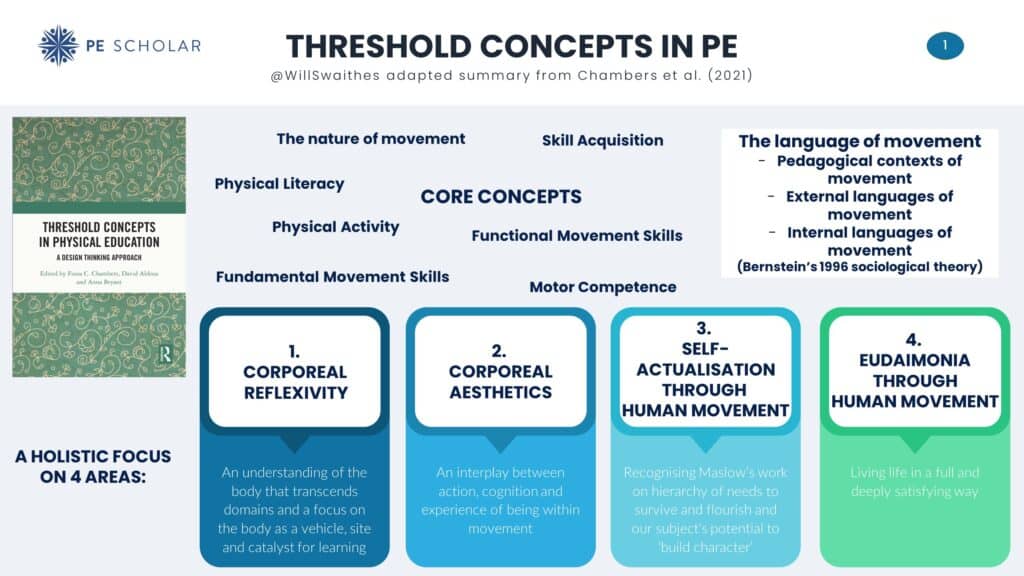
Part 1 – Core concepts
Exploring the nature of movement and related concepts such as physical activity, physical literacy, fundamental movement skills, functional movements skills, motor competence and skill acquisition is the core focus of this part of the book. As we know, socio-political and contextual factors influence what is considered valuable and significant learning in PE. This has resulted in a fairly ‘eclectic’ mix of claims (p7) over the years, but the purpose of enhancing movement and preparing for a healthy, active lifestyle remains a central and recurring theme. This is not new thinking, but it could be argued that many school systems around the world have drifted a long way from this focus. The key to success is ensuring that “practitioners are provided with the skills and knowledge to move beyond positions of ‘acceptance’ and ‘rejection’ of ideas, values and practices to one in which they are able to create new languages of and for movement that enable the continued transformation and evolution of PE through the 21st Century” (p8).
The ‘language of movement’ is explored utilising Bernstein’s (1996) Languages of Description . This allows identification of 3 connected elements of language (L1, L2 + L3) as follows (see p10, figure 1.1):
- Pedagogical contexts of Movement (L3)
- Strength & Conditioning
- Dance
- Sports Clubs & Activities
- Sports Therapy
- Primary/ Secondary Education
- Tertiary Education
- External Languages of Movement (L2)
- Fundamental Movement Skills (FMS)
- Motor Skill Competency
- Kinesiology
- Physical Literacy (including lived embodiment and existentialism)
- Laban’s Movement Analysis (including phenomenology and monism around mind and body)
- Arnold’s Dimensions of Movement (education in, through and about movement)
- Internal Languages of Movement (L1)
- Philosophical
- Psychological
- Physiological
- Biomechanical
- Pedagogical
- Sociological
Using this framework, Chambers et al., (2021) provide some fantastic examples of some current languages of description that have contributed to movement practices within PE (p10-17) but also some of the challenges that arise from ambiguity and interpretation of terms. For example, FMS as ‘building blocks’ of running, jumping and throwing or categories of stability, object control and locomotion or the ABCs of agility, balance and co-ordination.
This chapter makes clear that the understanding, practice and assessment of movement continues to evolve within PE and so too do the languages we use to conceptualise this. More time and work are needed to support practitioners to translate highly abstract philosophical ideas into forms for teaching practice.
The idea of a ‘Progression Threshold’ is explored in chapter 2 and how we help learners make that leap across the threshold.
“The metaphor of climbing Everest can be used to capture the learning journey as there are moments in that climb when there is a demand on the learner to apply what they know to an entirely new risky situation, for example, climbing a sheer ice wall (Chambers, 2007). It is in such circumstances that proactive conception (Perkins, 2006) is tested. Clearly, every discipline has concepts which the learner must grasp, but there are some concepts which are key to a deep understanding of a discipline” (p36).
To be an effective physical educator, it is important to know the concepts that unlock that step change in capability. Chambers et al., (2021) clearly articulate that students are able to look at problems in a completely new way once they have mastered threshold concepts (p26) and this is the case in other disciplines too. This ontological shift within our students is surely what inspires many of us to teach?
This chapter also goes on to look at the idea of flow or getting in the zone to experience ‘a telic, uplifting feeling of skill mastery, mental happiness, enhanced self-esteem, and a sense of intellectual enjoyment. Resulting in transcendence, ecstasy or euphoria state’ (p32). Perception of ability is offered as the significant factor affecting whether a flow state can be achieved (p33) and hence it is important PE teachers pitch lessons appropriately, support self-confidence and peer examples of a ‘perfect model’ to help more students find a flow like state more often, enabling them to get lost in the moment and feel a real connection with physical activity.
Referencing the work of Henry (1964) and Rosenfield (1992), Chambers and Duffy (2021) go on to discuss the nature of PE as ‘highly unusual as it is a cross-discipline, and within this, an interdiscipline, reaching out to a number of disciplines to make sense of learning through movement. This means it has both discipline-centric threshold concepts from those disciplines that inform it (anatomy, sociology, history, motor development, psychology, sports medicine, adapted physical activity etc.) and then those threshold concepts which are found in the hybrid space, which only PE can claim and which are yet to be identified’ (p37). Consequently, ‘PE can offer its own unique threshold concepts’ (p38).
Chambers et al., (2021) then discuss the potential of a design thinking approach to craft experiences that enable the progress towards threshold concepts. They describe how with a design thinking approach, you should spend 80% of time in the ‘problem space’ and just 20% of time in the ‘solution space’ to properly understand, observe, unpack points of view and then ideate, build a prototype and test respectively (p54). Is that the sort of balance you typically achieve when trying to change something or do you rush to quick fixes? Design thinking is a very human-centred approach to innovation and that is exactly what is needed when seeking to improve PE to be more relevant, more meaningful and more valuable to all stakeholders (students first but also parents, senior leadership teams, school governors, policy makers etc).
Part 2 – Movement case studies: A design thinking approach
In part 2 of the book seven movement case studies are presented to help bring ideas to life from the perspective of teachers and academics who have worked together to uncover concepts that are exclusive to PE and pedagogical approaches that are well placed to teach them.
The first case study comes from a collaboration between colleagues in Portugal and Ireland to explore Laban’s framework within gymnastics. They explored locomotion, weight transference, weight bearing and balance as well as body, effort, space and relationships to create a matrix that helps trainee teachers to be more innovative in their delivery of gymnastics lessons.
The second case study (p75) comes from a team of academics based in Wales who also looked at applying Laban’s principles but in the context of dance as a holistic activity to develop the following movement elements:
- body – the ‘what’ of movement and how different body parts interact)
- effort – the ‘how’ of movement to consider attitude, purpose and energy
- space – the ‘where’ of movement to consider directions, pathways and special tensions
- shape – the ‘why’ of movement to include relationships with the environment and others.
The following threshold concepts were proposed for dance (p85):
- sensory awareness
- imagery
- co-construction of sequence due to open mind and open dialogue between performer and PE teacher
- continual reflection on performance based on 4 movement elements identified above
- consider the influence of music to alter dynamics
- give time for experimentation
The third case study explores threshold concepts considered crucial to teaching but also experiencing parkour. It comes from experienced colleagues in Belgium via a socio-ecological model who suggest the following (p95):
- Agree to try a movement and perceive it as a possible challenge;
- Learn to control his/her movement to guarantee is/her safety (maintaining a low level of excitement, imagining the movement to be realised, identifying the possible risks);
- Demonstrate supportive behaviours to his/her classmates;
- Be able to show persistence;
- Show autonomy and creativity to find way to overcome barriers;
- Listen to his/her body.
- Develop a goal orientation for task mastery.
The fourth case study focused on outdoor education in Norway and explores the following:
- Safety education and risk management
- Social and motor competence development
- Health promotion
- Sustainable literacy development
- Cultural transmission
This case study concludes that the ‘promotion of different views of the relationship between humans and nature’ is also key to what is delivered in and through outdoor education (p108).
The fifth case study comes from Japan and the idea of instilling Reigi (Respect) through Budo (martial arts). It gives a detailed and qualitative account of insight gleamed from a three-year research project seeking to develop the key theme of reigi (respect) alongside safety, risk and enjoyment (p119). As we know, respect is referred to in policy documentation relating to PE from a range of other countries globally (including England) and hence has value as a ‘concept’ that is far broader than the activity. Again, question over whether transfer is possible to other activities such as basketball and soccer is flagged.
The sixth case study comes from Ireland to explore flow in Gaelic games from the perspectives of a group of academics, teachers and a high-performing athlete. It looks in detail at what the athlete says, thinks, feels and does to help understand the learning process. This case study draws on physical literacy and an understanding of psychological (referring to motivation and arousal), social, physical and cognitive domains. This case study also touches on attitudes towards competition.
The seventh and final case study seeks to explore the place of social and emotional learning (SEL) within the context of PE at a school in England. It looks specifically at the value of Teaching Personal and Social Responsibility (TPSR) as a model for this (p137). The following five areas (or competences) are key according to CASEL (p145):
- Self-awareness – need to understand emotions and demonstrate self-efficacy
- Self-management – to remain motivated and goal focused
- Responsible decision making – for the benefit of self and others
- Relationship skills – to co-operate and collaborate
- Social awareness – empathy and respect for diversity
I like the idea that “threshold concepts act as a bridge between content and skills, though they place emphasis on the latter. The content being learned is not the focus per se, but rather the means by which skills – such as SEL competencies – are developed, thereby facilitating ‘deeper learning’ for the individuals (Meyer & Land, 2003, as cited on p144). For me, the affective domain of learning that goes on in PE is what Claxton refers to as deeper aspects of the learning river and, whilst it is hard to measure progress in this domain, it is such a significant feature of our subject. The Ontario HPE curriculum discussed in this blog has a clear focus on SEL skills as well as healthy living, active living and movement competence. The idea of explicit intent and sustained implementation within practice is certainly captured in the latest Concept Curriculum 2.0.
Part 3 – Lessons learned: Threshold concepts for physical education
Chambers et al. (2021) suggest the lack of clear threshold concepts claimed by PE contribute to issues faced in terms of status and value compared to other core subjects. Four threshold concepts for PE are presented:
- Corporeal Reflexivity – an understanding of the body that transcends domains and a focus on the body as a vehicle, site and catalyst for learning (p154)
- Corporeal Aesthetics – an interplay between action, cognition and experience of being within movement (p156)
- Self-actualisation through Human Movement – recognising Maslow’s work on hierarchy of needs to survive and flourish and our subjects potential to ‘build character’ (p161)
- Eudaimonia through Human Movement – living life in a full and deeply satisfying way (p162)
When it comes to implementation, chapter 12 provides a range of examples of how to turn conceptual ideas into reality in lessons. A set of pedagogical principles to help translate the design thinking framework into a ‘Praxis Matrix’ is presented. It is important to note that Chambers et al. (2021) provide examples to stimulate creativity in ideas amongst others rather than as a prescriptive list.
The following Pedagogical Principles of Translation originally drawn up by Calvino (2016) are shared (p172) to help guide educators:
- Lightness – we must be agile in thinking to respond to possibilities
- Quickness – we need a sense of urgency and energy
- Exactitude – we need to be precise and accurate in translation of concepts and use of pedagogical approaches
- Visibility – we must be supported to imaginatively explore pedagogical possibilities
- Multiplicity – we should look beyond traditional disciplinary boundaries
- Carelessness – we need time and space to play with new ideas
An example of what this could look like through the new Welsh Health and Well-Being Area of Learning and Experience (AoLE) is provided. The book then concludes (p190) with 6 helpful design questions for consideration:
- What does it mean for pedagogy if we have to consider all four threshold concepts when planning for learning?
- Is it possible to plan for one threshold concept in isolation?
- What are sustainable assessment strategies for threshold concepts?
- How can we continue to map and validate new threshold concepts for physical education?
- How can physical educators work together in virtual and real settings to galvanise our profession as a learning community?
- What does the Covid19 pandemic mean for future offline/online/blended iterations of physical education and physical education teacher education?
- How can our professional community continue to do meaningful research during and post pandemic?
- What are the most agile ways of conducting and disseminating our research such that it impacts praxis?
Summary
It is clear that the concepts referred to in this book are essential to a traditional or more progressive version of PE and need careful consideration if we are to progress our subject. That said, when I hear the term concept (for example Lee Sullivan et al.’s Concept Curriculum) it is often used as a proxy for broader values, competences and ‘life skills’ that PE has the potential to develop. This book has positioned its holistic focus on:
- Corporeal Reflexivity
- Corporeal Aesthetics
- Self-actualisation through Human Movement
- Eudaimonia through Human Movement
I feel the following are important concepts for consideration too. Using the Languages of Description diagram (Chapter 11), perhaps these could be mapped onto the four threshold concepts):
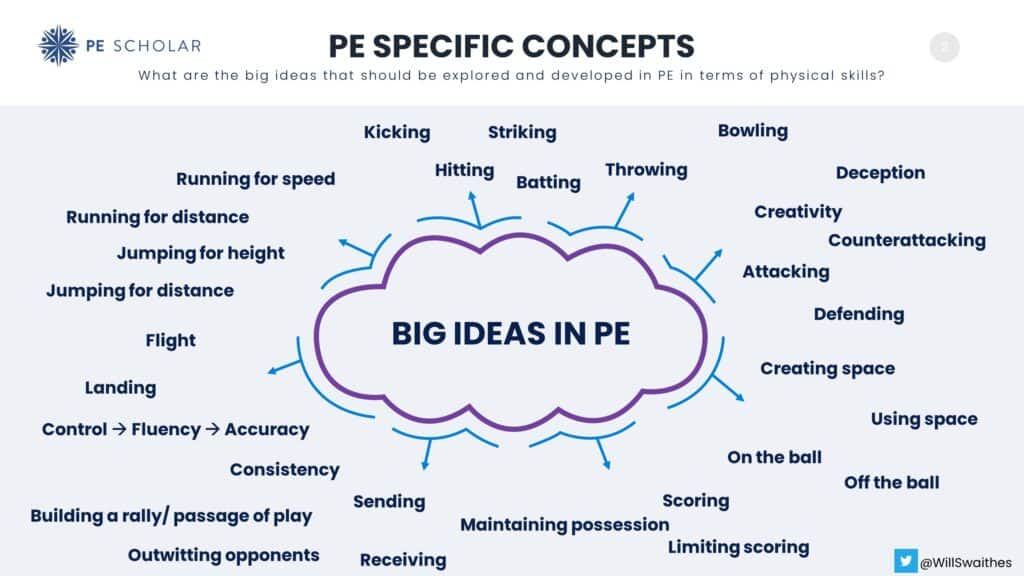
The above concepts are also pretty contained within the remit of physical education but then we have a whole host of what I call the ‘PRICELESS life skills’ or broader concepts that significantly equip young people for success in life and many recognise as worthy of more explicit focus in PE.
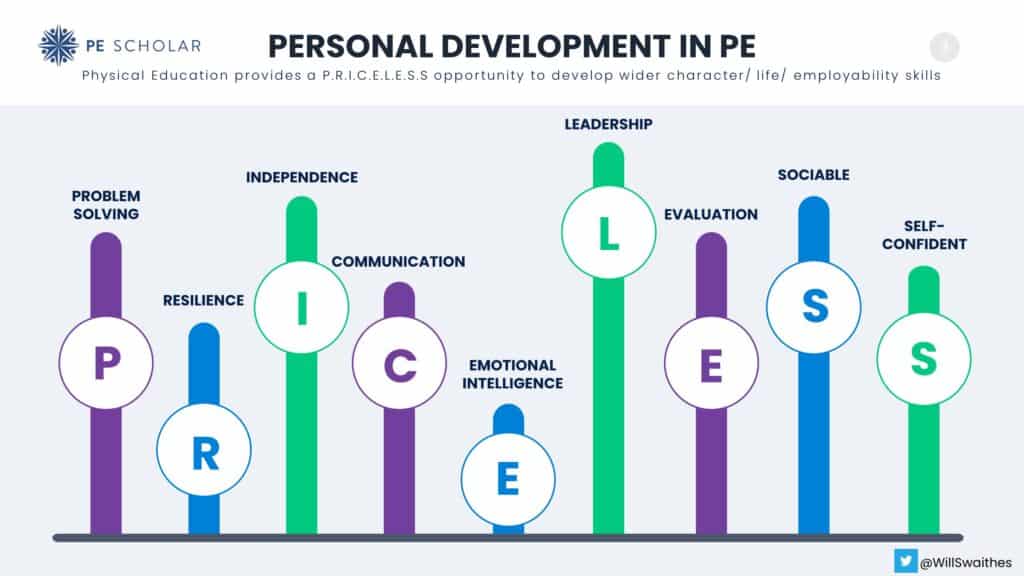
The jury is still out as to how and even if these things are transferred beyond their specific learning parameters, but I for one believe they can, that we should talk about them and certainly that they contribute to greater human flourishing so even in the absence of empirical evidence to support that claim it is still well worth at least some effort and focus by physical educators.
The following diagram suggests how we could align big ideas that are important within our subject mapped against the 4 Threshold Concept categories suggested in this book:
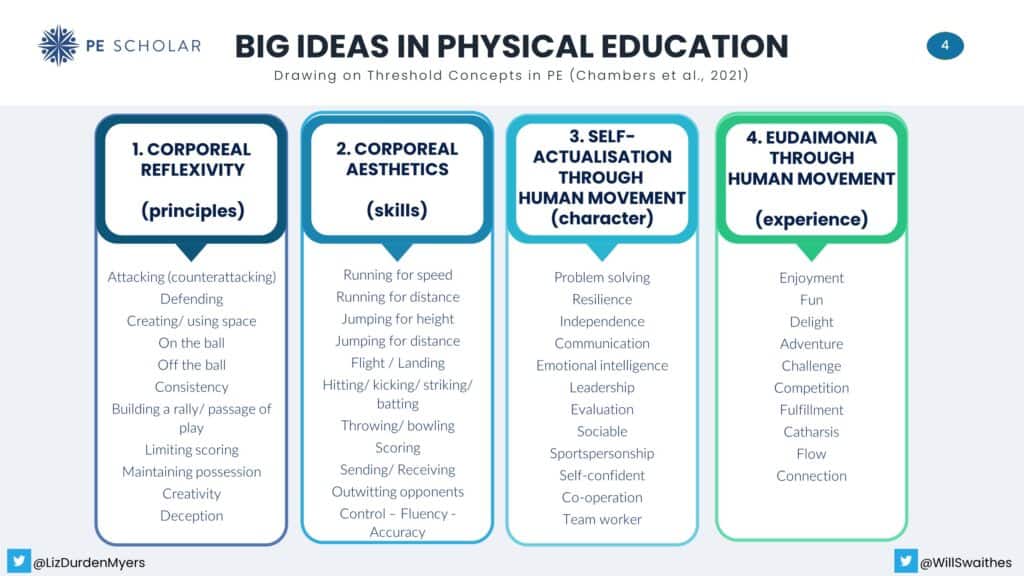
Reflective questions
On reviewing this blog, authors of the book Fiona, Dave and Anna would encourage you to think about the following questions:
- Linking TCs (Threshold Concepts) to content/skills is just a starting point and so, we wonder what micro concepts might be derived from the TCs, in your opinion?
- Rather than four siloed TCs, how might these TCs speak to each other/cross over (emergent transveral themes)? What content/skills areas could showcase these emergent transversal themes?
- In your opinion, what are the implications for pedagogy and PETE (Physical Education Teacher Education) if we use these TCs as a lens for our praxis?
Other book reviews
Here is a list of other book reviews you might want to check out:
Reviews by topic
Health and wellbeing
Happiness Factories: A success-driven approach to holistic Physical Education (podcast)
Time to RISE Up: Supporting Students’ Mental Health in Schools
Physical Education Pedagogies for Health
Inclusion and social justice
Inclusive PE for SEND Children and podcast
Teaching Disabled Children in Physical Education
Pedagogies of Social Justice in Physical Education and Youth Sport
Pedagogy
Applying Models-based Practice in Physical Education
Perspectives on Game-Based Coaching
The Future of Teaching and the Myths That Hold it Back
Meaningful PE – an approach for teaching and learning
The Spectrum of Teaching Styles in Physical Education and podcast
Reading lists
Also, don’t forget to take a look at these books published by Scholarly – indispensable additions to every PE teacher’s bookshelf.


[…] Threshold Concepts […]
[…] use sport education to develop leadership and interest. We are not dictated by activities and use key concepts to make connections to real world […]